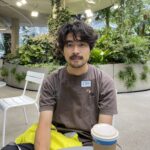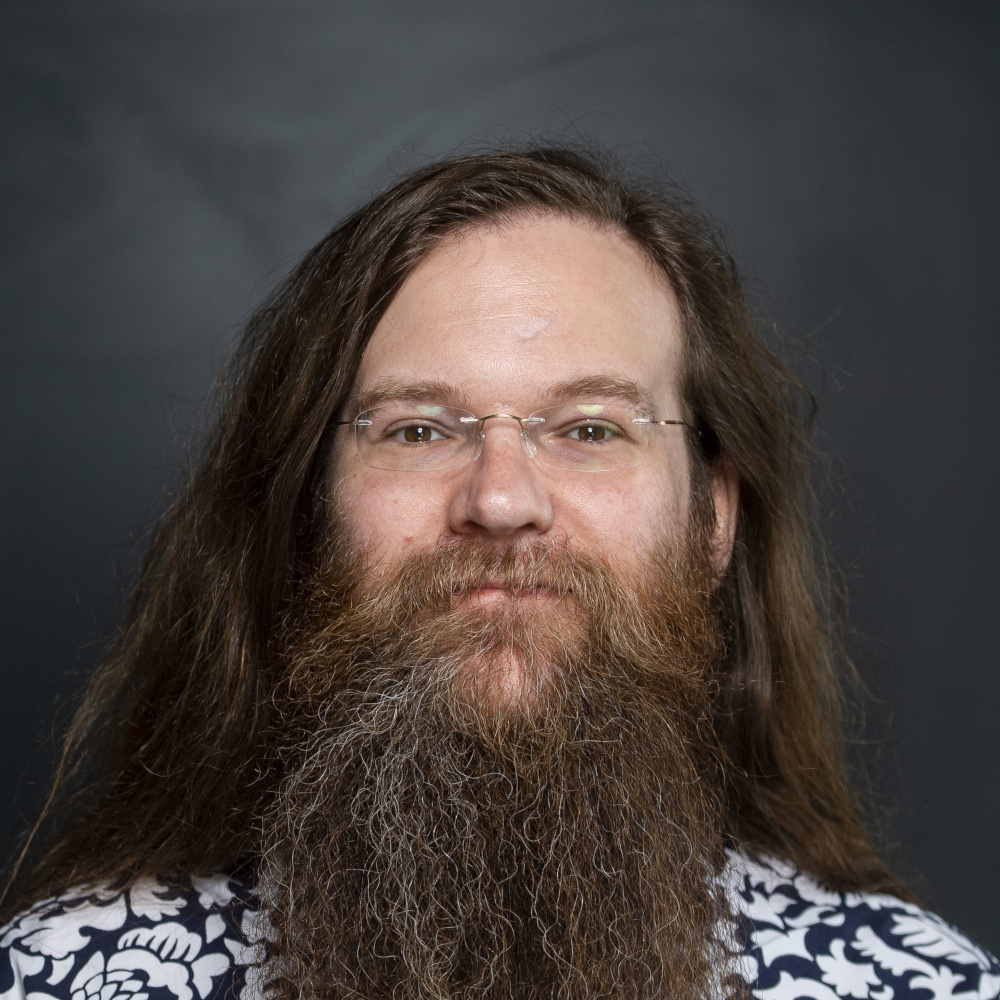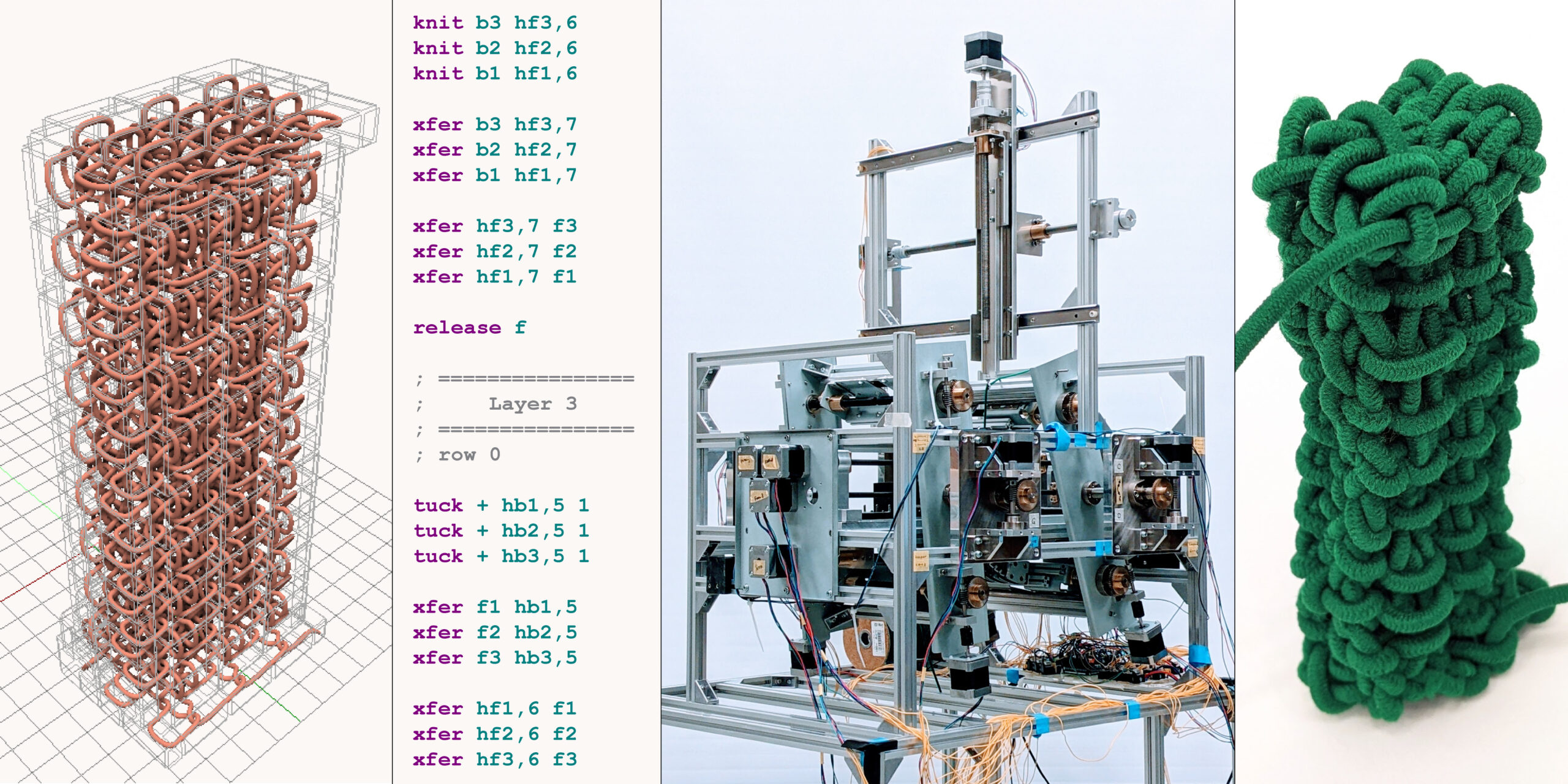Image Credit: © 2024 Yuichi Hirose, Mark Gillespie, Angelica Bonilla Fominaya, and James McCann
Explore how Yuichi Hirose, Mark Gillespie, Angelica Bonilla Fominaya, and James McCann collaborated to create “Solid Knitting,” a cutting-edge fabrication technique merging 3D printing’s layer-by-layer approach with knitting’s stitch structure. This innovative method produces solid 3D objects with intricate designs and robust structures, showcasing the fusion of technology and craftsmanship. The interdisciplinary approach opens new possibilities in digital fabrication, redefining modern manufacturing.
SIGGRAPH: Share an overview of “Solid Knitting.” What inspired this research?
Yuichi Hirose (YH): Solid Knitting is a new technique to fabricate dense, firm objects via knitting. It builds objects up layer by layer similar to 3D printing, but these layers are connected to each other by the topologically intertwined stitch structure of knitting. So, it can easily be unraveled and re-knit, unlike other 3D printing methods which require finished objects to be laboriously melted down and re-extruded into filament in order to be recycled. To automate solid knitting, we built a working prototype, solid knitting machine, and a design tool to help program the machine. In the tool, users design objects by connecting different types of blocks, what we call “augmented stitch volumes”. They are associated with code fragments that represent machine operations, described in a language we also developed, solid knitout. The tool combines the code fragments from each block into a program to run the machine.
I invented solid knitting in 2012-2014, when I was doing research on digital fabrication in my master’s program at Keio University. At the time, I was interested in programmable matter, digital materials, and claytronics. In these fields, researchers create reconfigurable objects by assembling a collection of modular robots or blocks into a 3D shape. I found myself particularly interested in the limitations of such reconfigurable objects: Although it is possible to create a 3D display with them, they are not strong enough to be used in applications where we actually apply a load to them. While thinking about this, I happened to come into contact with knitting. I learned that knitting is made up of a collection of individual stitches that form a whole, just like the reconfigurable objects which I was studying. And knitting is itself a reconfigurable method of fabrication, as it can be unraveled and re-knit. Furthermore, since the stitches are topologically connected to each other, they are highly stable and do not unintentionally come undone. I thought that if I could come up with a way to construct 3D dense objects by layering these, I could create practical reconfigurable objects in a more feasible way. This was the beginning of solid knitting.
SIGGRAPH: Tell us more about the fabrication technique used in “Solid Knitting.” How did you develop it? What sets it apart from traditional methods?
YH: As I mentioned above, I tried to come up with a way to construct 3D dense objects by layering knit fabric. To do so, I learned to knit, observed the fabric, and tried knitting dense objects. For the machine, too, I iterated to design, prototype, and test for multiple times. I started working on it again in 2018 as a freelancer after I worked in industry as a mechanical engineer for four years. Since then, I have continued designing and modifying the machine. Unlike standard knitting, which makes hollow surfaces, solid knitting makes dense volumes by layering knit sheets—much as 3D printers layer plastic sheets.
Mark Gillespie (MG): Solid knitting is sort of a fusion of knitting and 3D printing, but the dense yarn volumes which solid knitting creates have very different material properties than you can get from either traditional technique. Knitting is great for making hats and socks, because it creates soft surfaces into which you can put your head and feet. But because knitting just produces this hollow surface, knit objects don’t hold their shape independently — after you take your socks off, they just become floppy tubes rather than retaining the shape of your feet. At the other extreme, 3D printing creates rigid objects that are really good at retaining their shape but lack flexibility and softness — I would not want to walk around in 3D printed shoes or relax on a 3D printed sofa. Solid knitting offers a middle ground, producing results which feel very different from both traditional knitting and 3D printing. Solid-knit objects have enough internal structure to hold their shape but are still much softer and more flexible than rigid 3D prints. In this paper we only had time to scratch the surface of the kinds of objects and material properties that you can obtain via solid knitting, and I’m excited to see where this new fabrication technique goes.
James McCann (JM): Mechanically, Solid Knitting machines must be able to access a whole layer of loops (rather than just a row of loops, as in standard 2D knitting). This requires creatively re-thinking machine designs, since they now need to hold a 2D working set instead of a 1D working set of loops.
SIGGRAPH: How does the low-level language control the solid knitting machine, and what are its key functions?
YH: First, users can design solid-knit objects in a tool we developed by connecting different types of blocks, what we call “augmented stitch volumes”. They are associated with code fragments that represent machine operations, described in the low-level language, solid knitout, which we also developed. Much as other computer-numerically-controlled machines such as 3D printers, we can run the machine by sending the code. However, we should mention that because the current machine prototype often makes mechanical errors, we sent only several lines of the program at a time and checked if any errors occurred, fixed if it happened, and sent another group of lines. To reduce the mechanical errors is the first thing to work on as future development.
Angelica Bonilla Fominaya (ABF): As Yuichi mentioned, we utilize solid knitout which is based on a similar language also developed by the lab known as knitout, which similarly allows the construct of knit patterns on a traditional computerized knitting machine — such as a Kniterate or Shima Seiki machine. In Solid Knitting, this low-level language allows us to construct each knit, transfer, or tuck in a deliberate manner to construct various types of shapes and utilize the versatility of the machine. We are able to use a command, or a series of commands, to describe single stitches, which allows us to model how the design might look in the UI and directly translate it into something that can be read by the machine. This process also allows us to understand what types of patterns can be created, as we are able to analyze how each block (and set of instructions) moves through space — thus allowing us to logically prove if a pattern is possible (i.e., cycles are not introduced).
SIGGRAPH: How do you envision “Solid Knitting” being used in the future? What problems does it solve?
YH: Because solid knitting is dense, it can be used to create firm objects such as chairs. And because such an object is knit, it can be unraveled and returned to its original yarn. This makes it possible to “update” a physical object by, say, unraveling a chair and re-knitting it into a shoe. Since no special machinery is needed for unraveling, energy consumption and CO2 emissions from recycling itself and transportation to recycling plants can be significantly reduced. Furthermore, solid knitting has the potential to revolutionize the concept of physical objects. For example, when moving to a new house, if you unravel your previous occupant’s furniture and re-knit it into your own, you will be able to send and receive only data, not transport the object itself. In other words, the object can be treated as a type of software.
JM: Yuichi’s machine design is amazing, but we think we can do even better in the future. We’re looking at solid knitting larger and smaller objects, using new ways of holding and shaping the yarn, and generally at lowering the error rate and increasing the speed. There’s a whole world of machine design opportunities out there to explore, and we hope that other researchers and hobbyists also tackle the machine-design problem.
ABF: In the context of material exploration, there is a lot to still be investigated in defining the boundaries of what can be made with a solid-knit object. Outside of the technical implementation of the machine, there is a lot that can be done with varying types of yarn and even potential integration with soft robotics. The idea that solid knit patterns could contain varying densities or can be composed of different materials is incredibly exciting, and I am interested in seeing what can be created with just those two open questions.
SIGGRAPH: What do you hope SIGGRAPH 2024 participants take away from learning more about “Solid Knitting” in the Technical Papers sessions?
JM: I hope that it inspires folks to continue to look for new ways to make things.
ABF: I hope that it provides conversation around reusable fabrication, especially the potential solid knitting has as a material that can be repurposed, reshaped, or undone. I also think there is a lot of material exploration to be done in how we can construct solid-knit objects of different densities or textures (or how we can combine traditional knitting techniques in the development of objects). I hope people try out solid knitting, and hopefully become inspired to make things outside of the scope of this paper.
YH: There are many ways to construct fabric: knitting, crocheting, weaving, and so on, each of which has derivations. Similarly, the method we proposed to construct solid fabric objects is only one way. I hope people get interested in our research and some of them will come up with different methods we couldn’t have come up with. Same for the machine design. We are now trying to develop a better mechanism to automate solid knitting. I hope some people join to solve this problem.
Secure your spot at SIGGRAPH 2024 to access the latest insights in computer graphics and interactive techniques, and dive into our Technical Papers content on the full program.

Yuichi Hirose is a Ph.D. student in the Carnegie Mellon Robotics Institute. He develops a solid knitting machine, capable of knitting 3D dense objects. Objects created by this machine are reconfigurable as they can be unraveled and re-knit into something else.

Mark Gillespie just received a Ph.D. from the Carnegie Mellon University Computer Science Department. His work draws inspiration from classical topology and differential geometry to design algorithms for processing geometric data, with applications spanning from digital fabrication to shape analysis and physical simulation.

Angelica Bonilla Fominaya is a software engineer at Google and a Carnegie Mellon University alumna. She hopes to pursue research in HRI and fabrication to enhance creative experiences in technology.

James McCann is an associate professor in the Carnegie Mellon Robotics Institute. He builds “creative tools” – software and hardware systems that help people make things.



